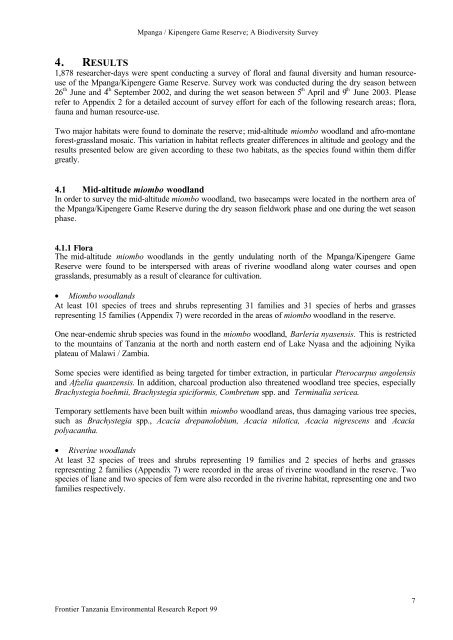Mpanga/Kipengere Game Reserve - Frontier-publications.co.uk
Mpanga/Kipengere Game Reserve - Frontier-publications.co.uk
Mpanga/Kipengere Game Reserve - Frontier-publications.co.uk
Create successful ePaper yourself
Turn your PDF publications into a flip-book with our unique Google optimized e-Paper software.
<strong>Mpanga</strong> / <strong>Kipengere</strong> <strong>Game</strong> <strong>Reserve</strong>; A Biodiversity Survey<br />
4. RESULTS<br />
1,878 researcher-days were spent <strong>co</strong>nducting a survey of floral and faunal diversity and human resourceuse<br />
of the <strong>Mpanga</strong>/<strong>Kipengere</strong> <strong>Game</strong> <strong>Reserve</strong>. Survey work was <strong>co</strong>nducted during the dry season between<br />
26 th June and 4 th September 2002, and during the wet season between 5 th April and 9 th June 2003. Please<br />
refer to Appendix 2 for a detailed ac<strong>co</strong>unt of survey effort for each of the following research areas; flora,<br />
fauna and human resource-use.<br />
Two major habitats were found to dominate the reserve; mid-altitude miombo woodland and afro-montane<br />
forest-grassland mosaic. This variation in habitat reflects greater differences in altitude and geology and the<br />
results presented below are given ac<strong>co</strong>rding to these two habitats, as the species found within them differ<br />
greatly.<br />
4.1 Mid-altitude miombo woodland<br />
In order to survey the mid-altitude miombo woodland, two basecamps were located in the northern area of<br />
the <strong>Mpanga</strong>/<strong>Kipengere</strong> <strong>Game</strong> <strong>Reserve</strong> during the dry season fieldwork phase and one during the wet season<br />
phase.<br />
4.1.1 Flora<br />
The mid-altitude miombo woodlands in the gently undulating north of the <strong>Mpanga</strong>/<strong>Kipengere</strong> <strong>Game</strong><br />
<strong>Reserve</strong> were found to be interspersed with areas of riverine woodland along water <strong>co</strong>urses and open<br />
grasslands, presumably as a result of clearance for cultivation.<br />
• Miombo woodlands<br />
At least 101 species of trees and shrubs representing 31 families and 31 species of herbs and grasses<br />
representing 15 families (Appendix 7) were re<strong>co</strong>rded in the areas of miombo woodland in the reserve.<br />
One near-endemic shrub species was found in the miombo woodland, Barleria nyasensis. This is restricted<br />
to the mountains of Tanzania at the north and north eastern end of Lake Nyasa and the adjoining Nyika<br />
plateau of Malawi / Zambia.<br />
Some species were identified as being targeted for timber extraction, in particular Pterocarpus angolensis<br />
and Afzelia quanzensis. In addition, char<strong>co</strong>al production also threatened woodland tree species, especially<br />
Brachystegia boehmii, Brachystegia spiciformis, Combretum spp. and Terminalia sericea.<br />
Temporary settlements have been built within miombo woodland areas, thus damaging various tree species,<br />
such as Brachystegia spp., Acacia drepanolobium, Acacia nilotica, Acacia nigrescens and Acacia<br />
polyacantha.<br />
• Riverine woodlands<br />
At least 32 species of trees and shrubs representing 19 families and 2 species of herbs and grasses<br />
representing 2 families (Appendix 7) were re<strong>co</strong>rded in the areas of riverine woodland in the reserve. Two<br />
species of liane and two species of fern were also re<strong>co</strong>rded in the riverine habitat, representing one and two<br />
families respectively.<br />
<strong>Frontier</strong> Tanzania Environmental Research Report 99<br />
7

















